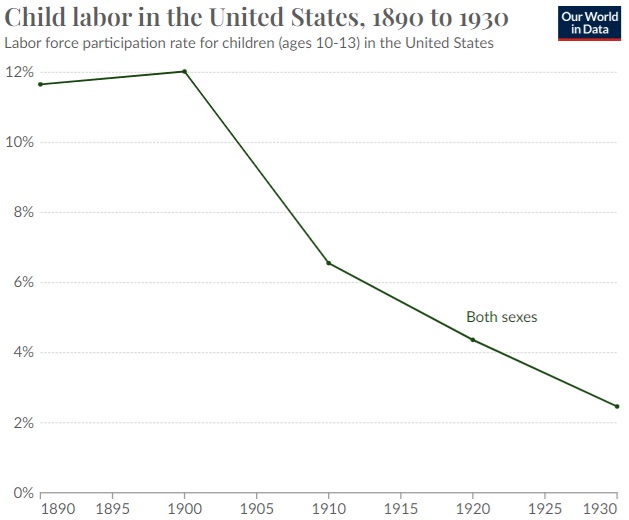July 3, 2024 by Dan Mitchell @ International Liberty
Two years ago, I explained how the industrial revolution helped catapult the western world to unimaginable prosperity.
Today, let’s build on that column by looking at some of the secondary benefits.
We’ll start with a chart from Our World in Data showing a big drop in the prevalence of child labor in the United States between 1890 and 1930.
What accounts for this decline?
It wasn’t because of politicians in Washington. They outlawed child labor in the 1930s, well after it had largely disappeared.
You can perhaps give some credit to compulsory education laws enacted by states, but the real story is that free markets created so much wealth that there no longer was a need for poor families to push kids into the labor market.
This is true in all nations that allowed capitalism (and a process that is still underway in other countries).
Here are some excerpts from a column by Larry Reed of the Foundation for Economic Education.
Child labor was relieved of its worst attributes not by legislative fiat but by the progressive march of an ever more productive capitalist system. Child labor was virtually eliminated when, for the first time in history, the productivity of parents in free labor markets rose to the point where it was no longer economically necessary for children to work to survive. The emancipators and benefactors of children were not legislators or factory inspectors but factory owners and financiers. Their efforts and investments in machinery led to a rise in real wages, to a growing abundance of goods at lower prices, and to an incomparable improvement in the general standard of living.
And here are some passages from an article by Marian Tupy for Human Progress.
…the Industrial Revolution has become tainted (in the popular imagination) with the very problems that it has helped to cure. Play a word association game with most high school and college students today, and you will observe the negative connotations linking the Industrial Revolution and environmental degradation, exploitation, child labor, poverty, hunger, etc. …
I am going to try to convince you of the opposite: that the Industrial Revolution, and the fossil fuels that powered it, contributed to the liberation of humankind. …Prior to the Industrial Revolution..very few ordinary people, mostly merchants and money-lenders, broke out of subsistence existence and escaped the vicious cycle of ceaseless manual labor, hunger and poverty. …as T. S. Ashton explains in his 1948 book The Industrial Revolution: 1760–1830, working conditions started to improve and wages started to rise. That, in turn, removed the need for child labor, which rapidly declined.
The moral of the story is that we are very lucky to be part of the modern world.
A couple of hundred years ago, we might have been struggling to survive a life of subsistence agriculture. Compared to that, we would have been delighted to work in a sweatshop with conditions that seem miserable compared to today.
And our lives have become successively richer since that time. At least in the nations fortunate enough to enjoy economic liberty.

No comments:
Post a Comment